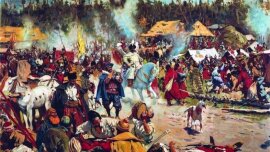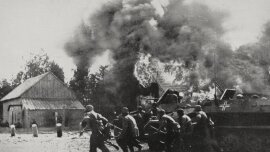The death of Daria Dugina received a wide public response, quarreled many users of social networks, and eventually took on the features of a myth about a sacred sacrifice. This myth has already found many believers, which is not surprising in the conditions of archaism, into which Russian society has plunged.
Archaization is the following of patterns and programs that developed in cultures that preceded the modern ones, and in Russian conditions, as a rule, those related to the periods of the ancient and medieval world [1]. These ancient programs were working, effective, but a long time ago, in conditions different from today's. For example, when a Russian is faced with the question "Why do I live like this?" Why is what is happening", then instead of analysis, he includes the binary logic of mythological thinking and answers to himself that everything is the fault of the "enemies" who are jealous of Russian "greatness" and are staging mutinies. In addition to the logic of "own-other" and conspiracy, sects have recently flourished in Russian society, especially of the para-Vedic-Ancient Slavic direction, the cult of the leader, belief in psychics, magical thinking, 5G towers, etc.
Rational work in the territory of myth is a vulnerable strategy, as those who try to desacralize myths and expose fakes know about. In the confrontation between the myth and the rational, in most cases the former wins. Therefore, I propose to consider this situation from the point of view of sacred sociology .
Sacred sociology is a term proposed by J. Bataille in the late 1930s in order to explore and articulate the hidden archaic forces of society that seem to be supplanted by modern forms of government. Zh. Bataille considered that the repressed inevitably returns, and in the most radical, destructive form.
Sacrifice and potlatch in ancient cultures
The most important ritual practice of archaic society is sacrifice. It performed an important social function - to preserve the human connection with the world of the sacred. In addition, according to Bataille, sacrifice, self-wasting is a vital human need: a surplus of life energy is collected in the community, and if it is not spent, then the accumulated surplus of energy can turn into violence within the community (revolution, civil war).
The central concept of archaic sacrifice is the potlatch . Potlatch is a ritual practice that involved a demonstrative waste of wealth. The gifts could be dedicated to the gods and destroyed, or given to other members of the tribe. If in a modern society status is confirmed by accumulated wealth, then in an archaic society it is the opposite. Status was confirmed by how much a person was willing to give or destroy. Appropriating the respect, the "prestige" that society bestowed on the spendthrift, became a form of symbolic self-aggrandizement that paid for the real costs.
In the potlatch ritual, the distribution of gifts within the community was intended to humiliate rivals, because the one to whom the gift was given had to repay with an even greater gift . If a person could not give thanks with an even greater gift after a certain time, he could lose his status as a free person, become a slave. In order to preserve one's property and high social status, it was necessary to spend properly: "The leader must organize a potlatch for himself, his son, son-in-law or daughter, for his dead. He maintains his rank in the tribe and village, even in his own family, he maintains his rank among chiefs nationally and internationally, only if he proves that spirits and wealth are constantly visiting him and favoring him, that it is not wealth that owns him, but that he owns wealth, and he can prove the existence of this wealth only by spending it"[2] . The inability to waste, to risk one's property and life, was considered unworthy of the upper stratum, the aristocracy.
So, when a chief gifted his fellow tribesmen with beads, cattle, or slaves, it was not a disinterested communist call, but an extravagance in exchange for gaining status and power. When the shaman said that Tezcatlipoca required a ritual ball game followed by the sacrifice of the defeated (or winners, there are different versions about this), then, for example, too many young aristocrats gathered, threatening the power of the old chief.
Remnants of the potlatch can be seen in modern society. For example, "washing" the first salary, organizing lavish corporate parties, flowers, fireworks (like spending on something that has no use). One of the manifestations of potlatch is the organization of weddings by the parents of young people "like a human". Perhaps the loan money will have to be paid back for years, perhaps the term of the loan will be longer than that marriage, but blood relatives and relatives of the child's partner should see that the family is "no worse than others." By the way, the release of violence is also sometimes considered an integral part of the wedding: for example, humorous humiliation of the bride and groom or their relatives, or a drunken fight among the guests.
Sometimes a potlatch was arranged for the gods, then the gifts were destroyed: "They allow the death of slaves, burn precious fat, throw copper products into the sea and even burn the houses of the chiefs..." [3] . It happened that the gods were given not a surplus, but what the tribe itself desperately needed, the last resources or the best fellow tribesmen: young, beautiful and noble. There was a certain logic in such, from a modern point of view, terrible and absurd actions. First, the victim's body united the tribesmen, and not only with each other in the profane world, but also with the sacred world. People made a sacrifice, the gods in return gave mana (prestige, charisma, farn [4] ), thus energy circulated between the living, the dead and the gods. This potlatch also required raising the stakes all the time to keep the energy from stagnating.The highest, most valuable gift was the voluntary conscious sacrifice of one's own life . Self-sacrifice was an almost divine act. Such a sacrifice was likened to Purusha, who in Hindu mythology sacrificed himself for the birth of the universe, or Sati, who went down in the fire because of the humiliation of her husband, Shiva.
However, not every leader or priest was happy to sacrifice himself, so there were smaller sacrifices aimed at substitution, "substitution of violence". R. Zhirar wrote: "The collective tries to turn on a relatively indifferent victim, on a "convenient" victim, the violence that threatens to affect its own members" [5] . Ancient Athenians rushed to such a replacement: they drove around the city all day a marginal person, to whom everyone showed respect, in order to kill her at the end. Such a sacrifice was called a pharmakon , and it was supposed to collect all the sins of the townspeople in order to get rid of them together with the pharmakon.
It seems that sacrifices have long become a thing of the past, but even in the modern world there are sacred sacrifices. For example, in 2011 in the state of Chhattisgarh in India, priests killed a 7-year-old girl for a good harvest, cut out her liver, and sacrificed it to the gods [6] . The police caught the performers, who confessed to the crime, but pleaded not guilty.
The palingenetic myth of the Nazis
The idea of a sacred sacrifice became a central element of the ideology of Nazism as part of palingenetic myths [7] . The main one was the myth of the Battle of Langermak. The real battle at Langermak is an event of the First World War, which was supposed to be a shame for the command of the Kaiser's army. Poorly trained and armed reservists, among whom there were many students and even high school students, were sent to attack trained English soldiers. As a result, about 2,000 German soldiers died. On this story, they built a myth about fearless children who, as if without the slightest hesitation, rushed into the attack, singing: "Germany, Germany, higher than all." Despite its unrealistic nature, the myth of the Battle of Langermac quickly became a staple in the repertoire of National Socialist propaganda with its annual ceremonies and the participation of prominent figures. The self-sacrifice of students and high school students, the heroism of the dead, Nazism turned into a philosophy of life in which the living and the dead were connected, and the living were to be responsible for the eternal memory of the dead.[8] , and the Hitler Youth choir proclaimed on Memorial Day: "The best of our people died not so that the living could die, but so that the fallen could live" [9] . On the example of fallen young soldiers, German children were brought up so that each of them would be happy to die for the Führer and the nation.
Alongside the collective victim, there was also a pantheon of individual Nazi "martyrs", such as Horst Wessel or Leo Schlageter . Horst Wessel was a Nazi activist, Sturmführer. His "sacred sacrifice" consists in the fact that he was attacked by members of the then-banned Union of Red Front Soldiers and wounded in the head by an activist of the Communist Party. Horst Wessel refused first aid because the doctor was Jewish and ironically died of a blood infection in the hospital.
Leo Schlageter distinguished himself with courage in the First World War, and in 1922 he joined the Nazi Party. A little later, he took up mining railways in order to stop the transport of coal to France, thereby undermining French control over the Ruhr region. He was arrested by the French and executed in 1923. After his death, he immediately became a Nazi icon.
In honor of the dead Nazi "heroes", solemn holidays were organized with ritual ceremonies, torches, speeches by famous persons, etc. During the celebration in honor of Leo Schlageter, after the last words of Heidegger's speech "We honor heroes and raise our hands in silent salute", about a thousand people present lowered their hands in silent salute [10] .
Palingenetic myths of Russian Nazism
Russia has its own large-scale palingenetic myth - the "Immortal Regiment". On the day of May 9, Russians carry out a large-scale march with photos of their ancestors who died during the Second World War. This holiday is accompanied by a parade of military achievements of the Russian military industry, children dressing up in military uniforms, concerts by singers of the patriotic echelon, "we can repeat" stickers on cars, and the implementation of the ritual "front-line 100 gr." and congratulating the living veterans with gifts that should remind them of the years of the terrible war, i.e., with what was named "Pobedobesie". The "Immortal Regiment" in Russia has now lost its significance as a part of historical memory, remaining purely mythological, or rather propagandist to the extent that a person who allows himself an expression that even slightly deviates from the official doctrine receives a public flogging from the main propagandists, hate in social networks and the introduction of a criminal case for the "rehabilitation of Nazism". The latter is quite understandable from the point of view of archaic motives. "Immortal Regiment" ("The Great Patriotic War") is an indicator that in the archaic binary thinking "you are either yours or the enemy", it helps to quickly identify the enemies.
The exploitation of the tragedy and heroism of those who fought the fascist invaders since the Second World War, carried to the extreme of cynicism, has one weak point for propaganda: where are the glorious descendants of the glorious grandfathers? Where are the heroes of the modern war against Ukraine? Did the imagination of the propagandists, who receive huge money, not give birth to anyone except the old woman with the red flag (who turned out not to be a supporter of the "Russian measure") and the "boy Alyosha" who meets the military and forbids his parents to leave the border area. True, there was a funny attempt to reanimate the myth of the politician Klochkov, who during the battle near Moscow, a few minutes before his own death, raised his platoon of tank destroyers to attack (this moment is recorded in the photo, where Klochkov - with a pistol in a high raised hand). The platoon had to repulse one of the continuous attacks of Guderian's tank armies.
They tried to link the death of the deputy commander of the Black Sea Fleet, Andrii Palia, to this myth, who "like a real commissar led the marines into battle" (according to the version of former naval officer Igor Savostin). In connection with this "feat", several questions arose: what is so bad about the marines that it has to be motivated by the second person of the Black Sea Fleet? Were other officers unable to perform their direct duties? What was the deputy commander of the fleet doing in the epicenter of the fight? We will probably never know this, but there is an obvious lack of heroes and even martyrs who would be truly remembered . "The myth of the death of the martyr Daria" still holds the information record.
The myth of an innocent martyr and ancient female sacrifices
The myth is, first of all, a structure, therefore "The Death of Daria" is built according to the classic structure: "an innocent girl became a victim of the treachery of infernal enemies." Darya is not just a propagandist, she is the daughter of Dugin, the heiress of Russian fascism. Propagandists call Daria a "girl", Dugin in a speech at the funeral says "my daughter's maiden life", the maiden status is constantly emphasized. If anyone has doubts about the innocence of a thirty-year-old woman, before her death she was not somewhere else, but at the "Tradition" festival. The murderers of Dugina were not just anyone either: the most terrible enemies in the Manichaean delusion of Putin's propaganda, the Azov Regiment, organized the explosion. There was a place and a miracle: Daria's father was saved at the last moment. After her death, a political canonization took place: the deceased was awarded the Order of Courage, and the Pope called her an innocent victim.
"The myth of the martyrdom of the innocent virgin Daria" appeared very timely. First, many people found out who Daria is and who Dugin is. Secondly, he re-digested the Russian liberals. Thirdly, the discussion of the myth became the main topic of social networks, pushing into the shadows the crime of the Russian regime: the murders of Ukrainian prisoners of war in Olenivka. It turns out that a dead martyr turned out to be more useful than a living propagandist of the second or third echelon.
In archaic patriarchal societies, which the Russian one looks like now, this was more often the case. In the sacred world, female sacrifice was considered more valuable than male sacrifice, because it was a greater waste due to its reproductive potential. Sacrifice of a woman seemed to endanger the existence of the entire race. At the same time, in the ordinary world, the death of a daughter, even of a royal family, did not worsen the life of the community in any way, unlike the death of a son, the heir. On the contrary, one mouth less, one extra dowry will remain in the royal treasury.
A living woman could at most become an object of exchange in marriage diplomacy, but a dead one could even bring success in military operations. For example, in antiquity, it was believed that the ritual shedding of the blood of a virgin prevents the blood of warriors from being shed in combat. Defending themselves from Minos, the Athenians sacrificed Anteida, Egleida, Lythea and Orthea - daughters of Hyacinth [11] , and for victory in the Trojan War, the king of Mycenae Agamemnon sacrificed his daughter Iphigenia.
The story of perhaps the most famous sacred sacrifice of Iphigenia [12] began with the fact that the king of Mycenae, Agamemnon, angered the goddess of hunting and Artemis. Because of this, Artemis sent a lack of wind, and the ships of the Greeks, which were going to the Trojan War, could not leave the port.
A "special operation" was planned against Troy to "liberate" Helen the Beautiful, the queen of Sparta and the wife of Menelaus, who did not want to be "liberated" at all, but wanted to live there happily ever after with the handsome Paris. However, in Helena's absence, her daughter, who has almost reached marriageable age, would become the next queen, and Menelaus would remain at his daughter's reception. Therefore, for the time being, the king of Sparta, Menelaus, gathered a team of kings and heroes to restore honor (and rob a little of rich Troy).
Realizing that the wind would not return on its own, Agamemnon sought advice from the soothsayer Calkhantus, who told him that the king should sacrifice his most beautiful daughter. Agamemnon resisted a little, but Menelaus persuaded him [13] . Then, under the pretext of marriage with Achilles, the heroes took Iphigenia from Clytemnestra. Calkhant had to stab the girl on the altar, not forgetting the fact: "so that she could not curse this one in her house, / Her mouth should be clamped, but tighter" [14]. At the last moment, Artemis took pity on the girl and replaced her with a goat or a doe. The goddess took the girl to Taurida, gave her immortality and made her a priestess in her temple. Having received psychological trauma from her father and his friends, Iphigenia, being a priestess herself, did not shy away from human sacrifices. The murder of her daughter probably did not have the best effect on marital relations, so Clytemnestra killed her husband immediately after returning from the war in order to rule together with her lover Aegisthus. The family tradition was continued by the joint son of the couple, Orestes, who killed his mother and great-uncle Aegisthus.
Daria Dugina as a sacred sacrifice
Could the death of Daria Dugina be a sacred sacrifice? All necessary prerequisites exist for this. First, the military situation, the successes in which look very doubtful for the Russian Federation compared to the declared ones. Secondly, a valuable victim is, according to modern ideas, a young and conditionally innocent girl, whose death came according to the Vedic or Zoroastrian tradition: in a fire. The sacrifice was given to the fire (farna) so that the farna would return multiplied. Third, there is a father who believes in magical rituals and whose personal philosophy would not prevent him from making such a sacrifice. Dugin imagines himself as a Superman who clearly "has the right" and not a "trembling creature" [15] .
As for the fascination with magic, Dugin was interested in it from the beginning of his creative career. In the 1960s, he was a member of a Moscow group that studied the occult under the leadership of the writer Yuri Mamleev [16] . After Mamleev's emigration, the other members of the band created the Black Order SS organization, which was headed by E. Golovin.
Dugin used magical techniques even during his election campaign in the State Duma. In 1995, at pre-election concerts for young people, members of the candidate's team read excerpts from the "Book of the Law" (authored by the famous occultist and supporter of black magic, A. Crowley), and actors, with the help of dolls, presented episodes from the sexual magic of the Order of the "Golden Dawn" [17] .
Magic did not help to win the election, so Dugin later switched to Old Believers and the primordial struggle between Hyperborea and Atlantis, which should end with the formation of the Eurasian Empire. However, Dugin did not finally break the connection with the occult: in the future, he continued to practice and popularize esoteric knowledge among young people. Journalist Andrii Loshak recalls an event led by Dugin and his daughter, where the occult mystery "Finis Mundi" was staged. By the way, Daria played the role of a sacrificial sacrifice there, performing self-immolation for the salvation of Russia [18] .
In a speech at the funeral, the father expressed his grief in these strange words: "Our hearts need more than just revenge or retribution. This is too trivial, not in Russian. We only need our Victory. My daughter laid her maiden life on her altar. So get the victory, please!". Revenge would follow the murder, and the sacrifice would be farn, victory.
The Sacrifice of Geriatric Nazism
Of course, all this is not enough to draw a conclusion about the organization of a sacred sacrifice by Daria's father, but she is still a sacred sacrifice, just like millions of Russian children, whose life and future will be exchanged or have already been exchanged for "greatness" and "stands up with knees". Because this whole war looks like one big sacrifice of young lives in order for the old to return to the days of their youth.
German Nazism was associated with young people who fanatically believed sincerely that dying for the nation and the Führer was the highest goal, he was in love with death, he was an aesthetic perversion of politics, "which brings the acceptance of death to the moment of triumph" [19] . Russian Nazism seems to make a parody of German Nazism: it has a distinct geriatric face. Young people are weakly interested in him, and support him the least among other age groups [20] . Then for whom is this "Russian measure" being made?
The surprise is that the "Russian measure" is not for the youth, not for the future, it is for all those old people who want to be eternally young in the eternal Soviet Union. For Brezhnev to speak before the chimes, for the smell of tangerines, "Olivier" on plates from the "Madonna" service, and Nadya pouring water on Zhenya Lukashyn on TV.
Old people are tired of constantly asking for help with the phone, with Internet banking, with Viber. They don't want to know what gender, cryptocurrency and barista are. They just want to be asked how to live, whom to marry, how to raise grandchildren, as it should be from time immemorial. So that the daughter-in-law wrote down the recipes of the dishes "eggplants like mushrooms", "cabbage cutlets", "beef soup in tomato" for the mother-in-law, and the son-in-law together with the father-in-law sorted through the old Zhiguli in the garage, hoping that one day the father-in-law would give them to him.
If for this you have to sacrifice the career of your son-in-law or daughter working in a foreign company, or your grandson's dream of becoming a travel blogger, then so be it. People lived without those foreign companies and without the Internet, and nothing. On the contrary: they were kinder, it was not scary to let a child go outside. What is the profession of "blogger"? It is a shame to look people in the eye, let him go to the army, it will wean him from computer games and make him a real man. And that arrogant son-in-law will stop making a big fuss about himself, teaching the elders who have lived their lives.
Mass child sacrifices were not something exceptional in human history. On the contrary: child sacrifice was prohibited only in Ancient Egypt [21] . Diodorus Sicilia writes that in 310 BC. the inhabitants of Carthage sacrificed 200 children to Baal to save the city from enemies. The ritual took place through the burning of the child in the arms of the statue of the deity. Near the city of Gezer in Palestine, children's skeletons were found in jars underground on the territory of the temple. Stories about child sacrifices can also be found in the Bible. The Middle Ages were marked by the Children's Crusade.
History also knew the "donation" of a child (often the firstborn) as a substitute sacrifice. For example, when an Inca or another important person fell seriously ill, they gave one of their sons to the deity instead of themselves, begging that the sacrifice be accepted instead of them.
Returning to Dugin, I would like to ask the question: how could a desire for magical rituals appear in the atheistic Soviet Union? The only explanation that can be found is hypercompensation. Dugin felt helpless and wanted to be all-powerful. He did not find real ways to achieve power, then magic came to his aid, which promised to solve his problems and realize his wishes with the help of secret knowledge and rituals. He was not unique in his belief in the irrational: in the 1990s, people gladly rushed into religion, some into a sect, some into psychics, some began to study Castaneda or practice Crowley's magic. Weakness and confusion in real life, the former "Soviet people" tried to compensate by interaction with forces higher than human.
Most researchers of fascism believe that the main reason for it is resentment caused by the humiliation of the country. However, an unclear point remains: how does resentment turn into fascism?
Yuriy Romanenko in our conversation [22] expressed the assumption that for the Russian Federation, the war against Ukraine is a manifestation of potlatch. That could explain a lot. For example, the incomprehensible "generosity" in shelling - at the beginning of the war, the Russian army sometimes fired millions of dollars worth of charges into chicken coops purely for the sake of prestige, to show that they have these missiles, and there are a lot of them. A separate issue regarding the destruction of residential areas - this has caused more problems than benefits. It is clear that there is pleasure in sadism, but does it cost too much?
Imposing one's culture on everyone, actions against Russophobia, huge budgets spent on bots, experts, and bloggers looks like the same potlatch. Recently, Russian renditions of Ukrainian songs appeared on YouTube, which looked like a "gift in return". It is not in the rules of Potlach to leave something unanswered (it sometimes reduces the status of the participant to the status of a slave), so they took strong emotional Ukrainian songs, translated them, sang them over and "gave them away".
Perhaps the potlatch is the tool that will help explain the transition to fascism. The "humiliation" of the country (or the declaration of humiliation, the fixation of a certain event as humiliation) leads to the destruction of the existing identification ("Soviet person") and the need to construct a new one. There are two ways here: finding a new identity, acquiring new social roles, adapting to changes - this is the way of an adult personality. The second way is archaization, a return to ancient programs, which Russians prefer throughout their history. It is similar to how a drunk decides to move around because he loses his balance while standing: he eventually gets to bed, even though he has lost the experience of the evolutionary achievement of the homo erectus period.
Because of the "humiliation", Russia feels jealous of the West with its dominance in almost all spheres. Russia wants to be noticed too, in the minds of Putin's elite there is a need to make a bid for dominance. Archaization suggests that there was once a working tool, a potlatch, and a decision is made to make the first gift. And not in science, not in culture, not in technical achievements, not in information technologies, not even in the space sphere, the Russian Federation has nothing to offer. However, she feels the weakness of the Western man - fear of war, reluctance to participate in hostilities, to put life at risk, and accordingly makes an application in this area.
Along with its claim to dominance, the Russian government is solving another problem through the potlatch: the redistribution of violence. In a society with such class inequality and extremely demonstrative consumption, a huge amount of aggression arises, and with limited social elevators, such aggression accumulates within the community. In order to take this aggression out of society, a "common enemy" is created. When this is not enough, excess aggression is "given as a gift" in the form of war. By the way, in the terms of the potlatch, the "abolition" of Russian culture is the correct, asymmetrical response recommended by Baudrillard. It was necessary to respond to the massive missile attacks in such a way that it was an increase in the rate. On a symbolic level, culture is higher than weapons (because weapons are made by people, and talent and inspiration are given by the gods), and accordingly, its return is higher than aviation and artillery.
The death of Russian youth as payment for "greatness"
The death of the propagandist Dugina is discussed either out of curiosity about the customer, or to find out what exactly one should feel: sympathy, indifference or malice. The impact caused by the death of a little-known girl shows that there is more to this event than the mere fact that something is hidden behind it. Under Dugina's noisy emphasis on the sacredness and uniqueness of death, the terrible fact that she is a sacral sacrifice, only not unique, but one of millions, is silenced. Sacrifices that have already been made are being made and will be made.
Geriatric fascism wants to win the war and is ready to sacrifice any number of other people's children, destroying them physically or destroying them mentally. For the sake of feeling important again in an understandable world, in a "great" country. It is symptomatic that no one knows what a "great" country should be, so everyone puts their own meaning. Someone dreams of the resurrection of the zombie USSR, someone of the Eurasian Empire, and someone of an ethnically pure Russia. The main thing is for this country to be "great", scary and anti-modern. So that there would be a place in it for the frightened old men, who with trembling hands mightily drag the children into the fiery embrace of the bronze Baal-Hammon, in order to bargain for a few more moments of life.
However, I would like to remind you that the most valuable thing for higher powers has always been the voluntary "donation" of one's life. Moreover, this is not black magic with dubious effectiveness, it really works. At the end of the Second World War, Hitler and a number of other Nazis "sacrificed" their lives - and Germany is now a successful, strong country, which cannot be said about countries in which dictators were brought to a natural death.
[1] Akhiezer A.S. Archaization in Russian society as a methodological problem // Public sciences and modernity. – 2001. – No. 2. – P. 89-100., P. 89.
[2] Moss M. Essay on gift. The form and basis of exchange in archaic societies // Society. exchange Personality / trans. with Fr. M.: Vost. Lit., 1996. P. 83–222. - P.146-147.
[3] Moss M. Essay on gift. The form and basis of exchange in archaic societies // Society. exchange Personality / trans. with Fr. M.: Vost. Lit., 1996. P. 83–222. - P. 107.
[4] Farn is an ancient Iranian definition for the material emanation of divine fire, solar shining beginning, glory, royal glory, good, peace, charisma, power, something desired, etc.
[5] Zhirar R. Violence and the sacred. M.: New Literary Review, 2000. 400 p. - p. 10.
[6] https://indianexpress.com/article/news-archive/web/in-chhattisgarh-village-cops-see-human-sacrifice-in-girls-mystery-death/
[7] The palingenetic myth is, according to D. Griffin, a component of the fascist minimum, the myth that the period of so-called decline will inevitably be replaced by rebirth and rejuvenation through a new post-liberal order. Griffin argues that the unique synthesis of palingenesis and ultranationalism distinguishes fascism from parafascism and other authoritarian nationalist ideologies.
Palingenesis (from the ancient Greek πάλιν - again and γένεσις - formation, birth) is the theory of the German philosopher Arthur Schopenhauer that the human will never dies, but manifests itself again in new individuals. The theory of palingenesis was set forth in the second volume of his book "The World as Will and Representation."
[8] Neocleous Mark Long live death! Fascism, resurrection, immortality, the cult of the fallen soldier as an important part of fascist ideological guidelines., P. 149.
[9] Ibid.
[10] Ibid, P. 151.
[11] Apollodorus. Mythological library / trans. V. S. Podshivalov according to ed. J. Fraser. Fit ed. V.G. Borukhovich. - L.: Nauka, 1972. - Apollodorus, Bib. III, XV, 8.
[12] Aeschylus, Euripides, Sophocles, Poliiides, Gluck, Goethe, M. Eliade, F. Brown and others addressed her
[13] According to one of the versions, Iphigenia, the most beautiful daughter of Agamemnon, was the illegitimate daughter of Helen from Theseus, adopted by the royal couple. Of course, an illegitimate daughter could not claim the throne of Sparta, but if she married the hero Achilles, who was just courting her... Perhaps the deceived husband Menelaus was not as simple as he seemed. By the way, sincere belief in the afterlife and extreme practicality coexisted harmoniously in mythological thinking.
[14] Aeschylus. Tragedies / trans. from ancient Greek S. Apta. – M.: AST; Kharkov: Folio, 2001. - P. 238-247.
[16] Some of the group's practices are described in Mamleev's novel "Chatuny".
[17] An occult order, a continuation of the occult European tradition, in particular the teachings of the Rosicrucians; arose at the end of the 19th century.
[18] https://tjournal.ru/u/387130-musoka/723462-zhurnalist-andrey-loshak-pro-dugina?comments&fbclid=IwAR0A6nk2K5jWkDQ2Oefp9XucqXHp2NfzbUO4r5MnmGonOsRT6rAWuhaP740
[19] Baudrillard, J. Symbolic Exchange and Death. - London, 1993. - P. 186.
[21] Taylor E.B. Primitive culture: trans. with English M., 1989., Fraser D.D. Folklore in the Old Testament. M., 1985. 512 p.

























